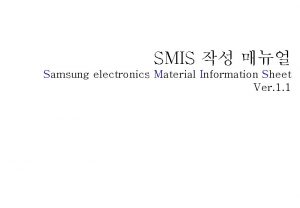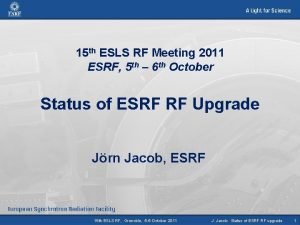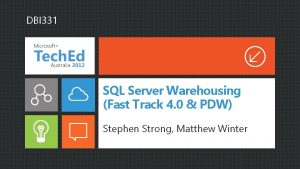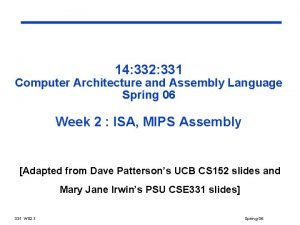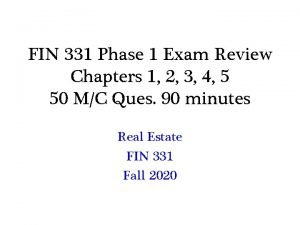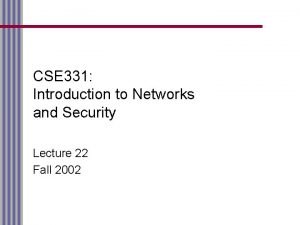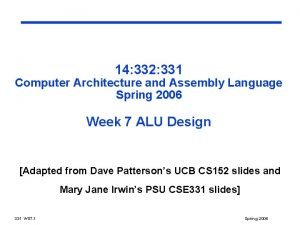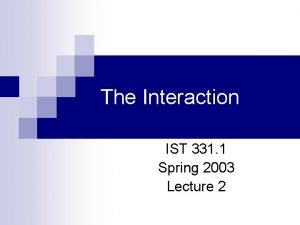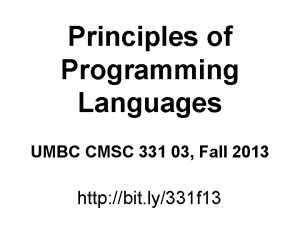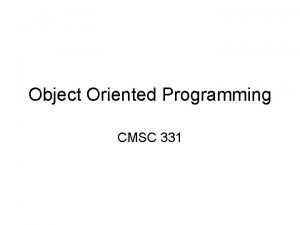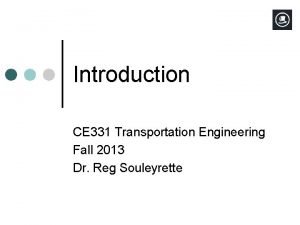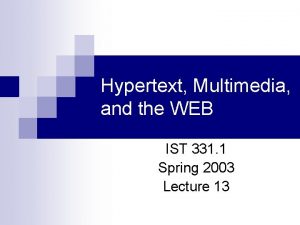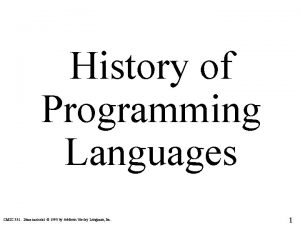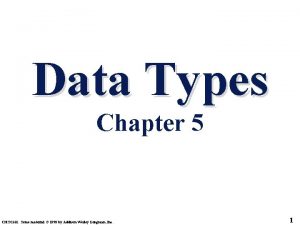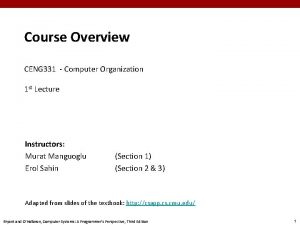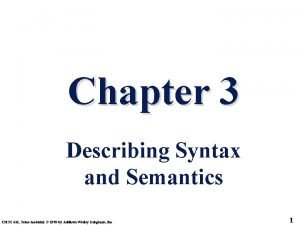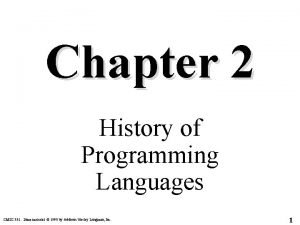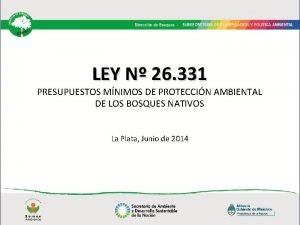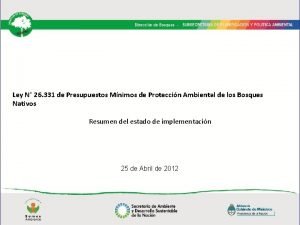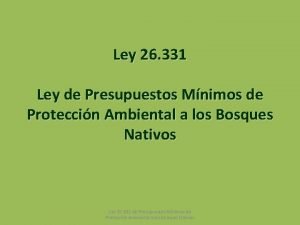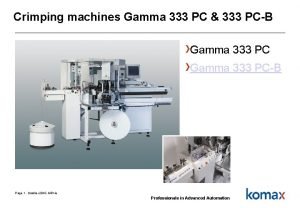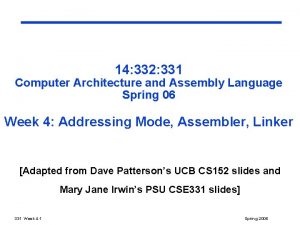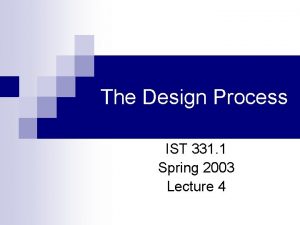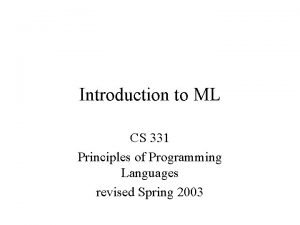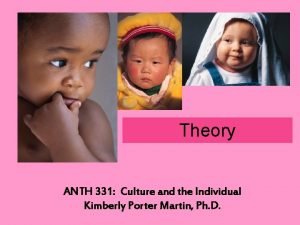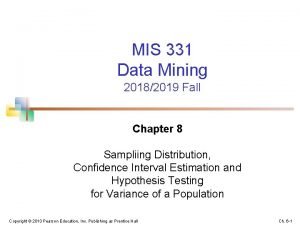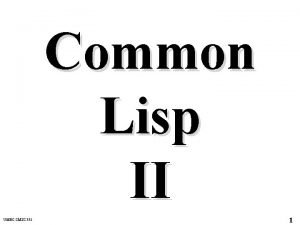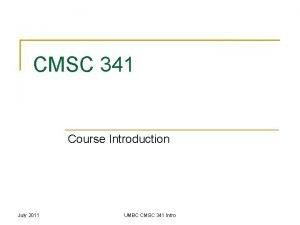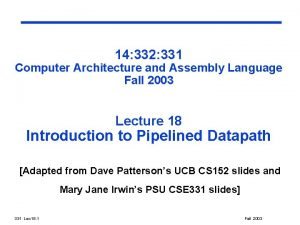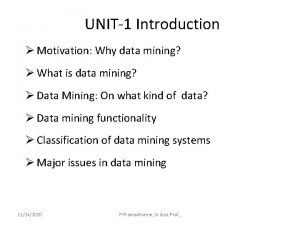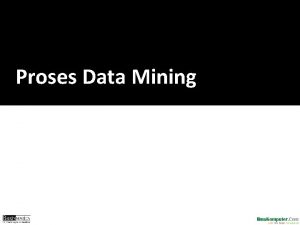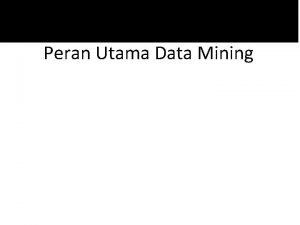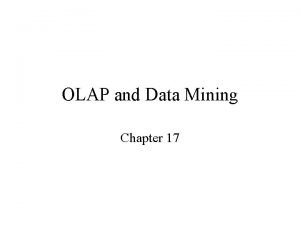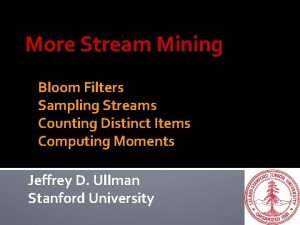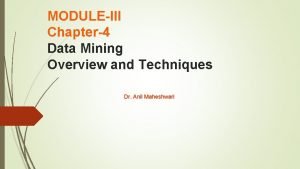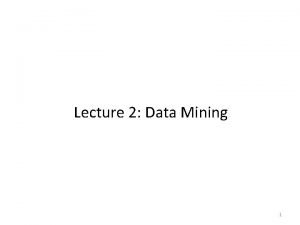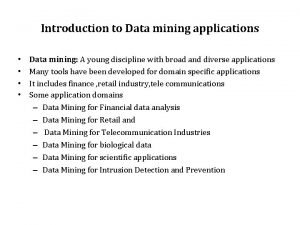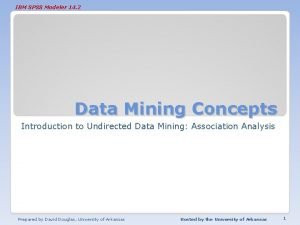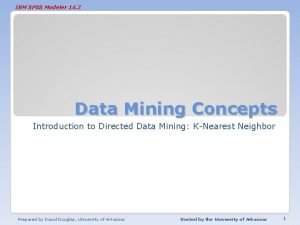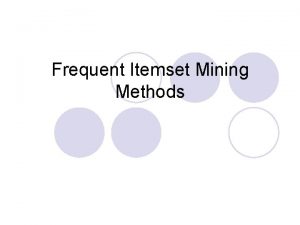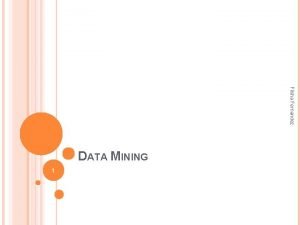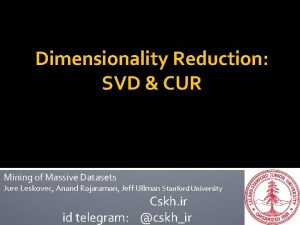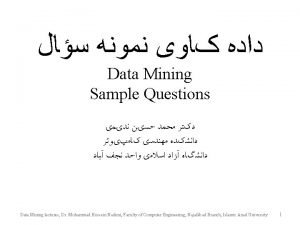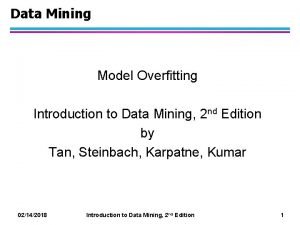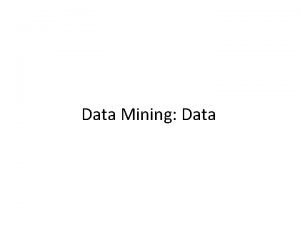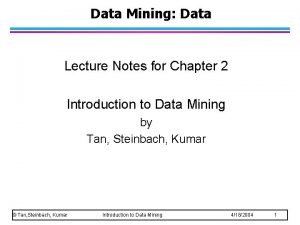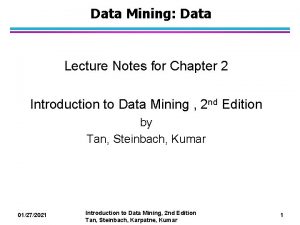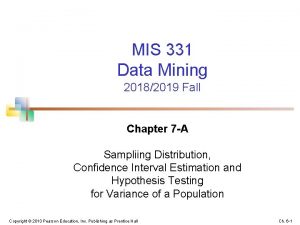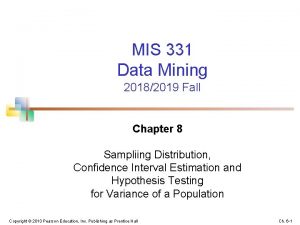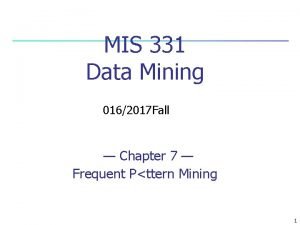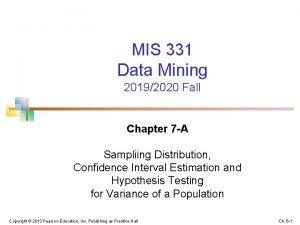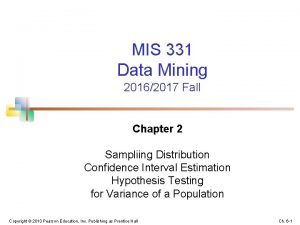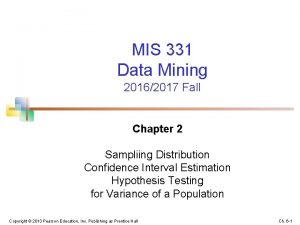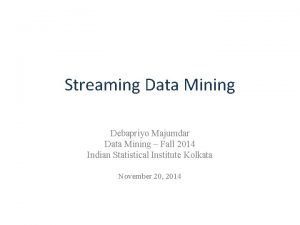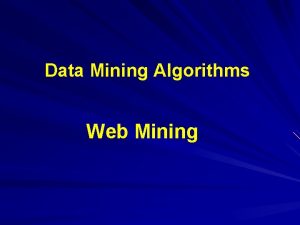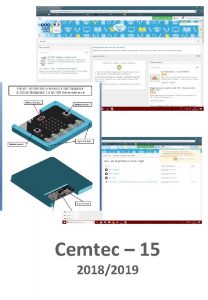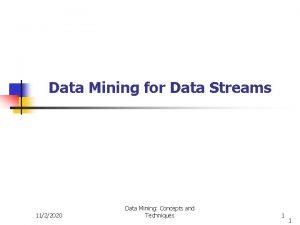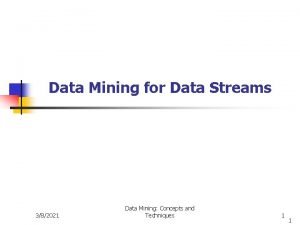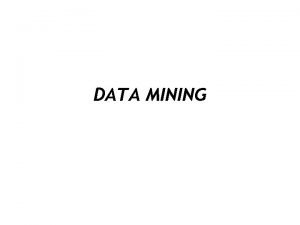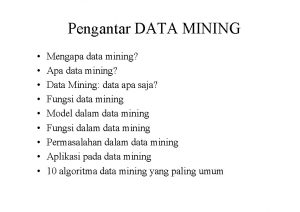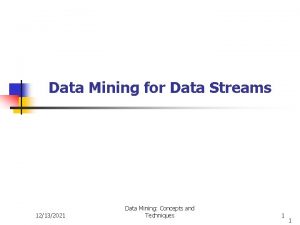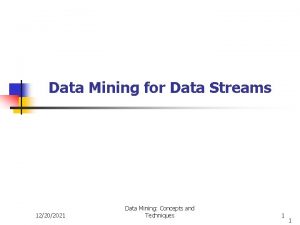SMIS 331 Data Mining 20182019 Fall Chapter 8




























































































- Slides: 92

SMIS 331 Data Mining 2018/2019 Fall Chapter 8 -B Multiple Regression Copyright © 2013 Pearson Education, Inc. Publishing as Prentice Hall Ch. 11 -1

Statistics for Business and Economics 8 th Edition Chapter 12 Multiple Regression Copyright © 2013 Pearson Education, Inc. Publishing as Prentice Hall Ch. 12 -2

Chapter Goals After completing this chapter, you should be able to: n Apply multiple regression analysis to business decisionmaking situations n Analyze and interpret the computer output for a multiple regression model n Perform a hypothesis test for all regression coefficients or for a subset of coefficients n Fit and interpret nonlinear regression models n n Incorporate qualitative variables into the regression model by using dummy variables Discuss model specification and analyze residuals Copyright © 2013 Pearson Education, Inc. Publishing as Prentice Hall Ch. 12 -3

12. 1 The Multiple Regression Model Idea: Examine the linear relationship between 1 dependent (Y) & 2 or more independent variables (Xi) Multiple Regression Model with K Independent Variables: Y-intercept Population slopes Copyright © 2013 Pearson Education, Inc. Publishing as Prentice Hall Random Error Ch. 12 -4

Multiple Regression Equation The coefficients of the multiple regression model are estimated using sample data Multiple regression equation with K independent variables: Estimated (or predicted) value of y Estimated intercept Estimated slope coefficients In this chapter we will always use a computer to obtain the regression slope coefficients and other regression summary measures. Copyright © 2013 Pearson Education, Inc. Publishing as Prentice Hall Ch. 12 -5

Three Dimensional Graphing Two variable model y ia e p lo r fo r va e bl x 1 S x 2 le x 2 Slop ariab e for v x 1 Copyright © 2013 Pearson Education, Inc. Publishing as Prentice Hall Ch. 12 -6

Three Dimensional Graphing (continued) Two variable model y yi Sample observation < < yi ei = (yi – yi) x 2 i x 1 Copyright © 2013 Pearson Education, Inc. Publishing as Prentice Hall < x 1 i x 2 The best fit equation, y , is found by minimizing the sum of squared errors, e 2 Ch. 12 -7

12. 2 Estimation of Coefficients Standard Multiple Regression Assumptions n n n 1. The xji terms are fixed numbers, or they are realizations of random variables Xj that are independent of the error terms, εi 2. The expected value of the random variable Y is a linear function of the independent Xj variables. 3. The error terms are normally distributed random variables with mean 0 and a constant variance, 2. (The constant variance property is called homoscedasticity) Copyright © 2013 Pearson Education, Inc. Publishing as Prentice Hall Ch. 12 -8

Standard Multiple Regression Assumptions (continued) n n 4. The random error terms, εi , are not correlated with one another, so that 5. It is not possible to find a set of numbers, c 0, c 1, . . . , ck, such that (This is the property of no linear relation for the Xjs) Copyright © 2013 Pearson Education, Inc. Publishing as Prentice Hall Ch. 12 -9

n The coefficient estimators are computed using the following equations:


Example: 2 Independent Variables n A distributor of frozen desert pies wants to evaluate factors thought to influence demand n n n Dependent variable: Pie sales (units per week) Independent variables: Price (in $) Advertising ($100’s) Data are collected for 15 weeks Copyright © 2013 Pearson Education, Inc. Publishing as Prentice Hall Ch. 12 -12

Pie Sales Example Week Pie Sales Price ($) Advertising ($100 s) 1 350 5. 50 3. 3 2 460 7. 50 3. 3 3 350 8. 00 3. 0 4 430 8. 00 4. 5 5 350 6. 80 3. 0 6 380 7. 50 4. 0 7 430 4. 50 3. 0 8 470 6. 40 3. 7 9 450 7. 00 3. 5 10 490 5. 00 4. 0 11 340 7. 20 3. 5 12 300 7. 90 3. 2 13 440 5. 90 4. 0 14 450 5. 00 3. 5 15 300 7. 00 2. 7 Copyright © 2013 Pearson Education, Inc. Publishing as Prentice Hall Multiple regression equation: Sales = b 0 + b 1 (Price) + b 2 (Advertising) Ch. 12 -13

Estimating a Multiple Linear Regression Equation n Excel can be used to generate the coefficients and measures of goodness of fit for multiple regression n Data / Data Analysis / Regression Copyright © 2013 Pearson Education, Inc. Publishing as Prentice Hall Ch. 12 -14

Multiple Regression Output Regression Statistics Multiple R 0. 72213 R Square 0. 52148 Adjusted R Square 0. 44172 Standard Error 47. 46341 Observations ANOVA Regression 15 df SS MS F 2 29460. 027 14730. 013 Residual 12 27033. 306 2252. 776 Total 14 56493. 333 Coefficients Standard Error Intercept 306. 52619 114. 25389 2. 68285 0. 01993 57. 58835 555. 46404 Price -24. 97509 10. 83213 -2. 30565 0. 03979 -48. 57626 -1. 37392 74. 13096 25. 96732 2. 85478 0. 01449 17. 55303 130. 70888 Advertising Copyright © 2013 Pearson Education, Inc. Publishing as Prentice Hall t Stat 6. 53861 Significance F P-value 0. 01201 Lower 95% Upper 95% Ch. 12 -15

The Multiple Regression Equation where Sales is in number of pies per week Price is in $ Advertising is in $100’s. b 1 = -24. 975: sales will decrease, on average, by 24. 975 pies per week for each $1 increase in selling price, net of the effects of changes due to advertising Copyright © 2013 Pearson Education, Inc. Publishing as Prentice Hall b 2 = 74. 131: sales will increase, on average, by 74. 131 pies per week for each $100 increase in advertising, net of the effects of changes due to price Ch. 12 -16

Example 12. 3 n n n n Y profit margines X 1: net revenue for deposit dollar X 2 nunber of offices Y = 1. 56 + 0. 237 X 1 -0. 000249 X 2 Corrleations Y X 1 -0. 704 X 2 -. 0. 868 0. 941

n n Y = 1. 33 -0. 169 X 1 Y = 1. 55 – 0. 000120 X 2

12. 3 Explanatory Power of a Multiple Regression Equation Coefficient of Determination, R 2 n n Reports the proportion of total variation in y explained by all x variables taken together This is the ratio of the explained variability to total sample variability Copyright © 2013 Pearson Education, Inc. Publishing as Prentice Hall Ch. 12 -19

Coefficient of Determination, R 2 Regression Statistics Multiple R 0. 72213 R Square 0. 52148 Adjusted R Square 0. 44172 Standard Error Observations ANOVA Regression 52. 1% of the variation in pie sales is explained by the variation in price and advertising 47. 46341 15 df SS MS F 2 29460. 027 14730. 013 Residual 12 27033. 306 2252. 776 Total 14 56493. 333 Coefficients Standard Error Intercept 306. 52619 114. 25389 2. 68285 0. 01993 57. 58835 555. 46404 Price -24. 97509 10. 83213 -2. 30565 0. 03979 -48. 57626 -1. 37392 74. 13096 25. 96732 2. 85478 0. 01449 17. 55303 130. 70888 Advertising Copyright © 2013 Pearson Education, Inc. Publishing as Prentice Hall t Stat 6. 53861 Significance F P-value 0. 01201 Lower 95% Upper 95% Ch. 12 -20

Estimation of Error Variance n Consider the population regression model n The unbiased estimate of the variance of the errors is where n The square root of the variance, se , is called the standard error of the estimate Copyright © 2013 Pearson Education, Inc. Publishing as Prentice Hall Ch. 12 -21

Standard Error, se Regression Statistics Multiple R 0. 72213 R Square 0. 52148 Adjusted R Square 0. 44172 Standard Error 47. 46341 Observations ANOVA Regression The magnitude of this value can be compared to the average y value 15 df SS MS F 2 29460. 027 14730. 013 Residual 12 27033. 306 2252. 776 Total 14 56493. 333 Coefficients Standard Error Intercept 306. 52619 114. 25389 2. 68285 0. 01993 57. 58835 555. 46404 Price -24. 97509 10. 83213 -2. 30565 0. 03979 -48. 57626 -1. 37392 74. 13096 25. 96732 2. 85478 0. 01449 17. 55303 130. 70888 Advertising Copyright © 2013 Pearson Education, Inc. Publishing as Prentice Hall t Stat 6. 53861 Significance F P-value 0. 01201 Lower 95% Upper 95% Ch. 12 -22

Adjusted Coefficient of Determination, n n R 2 never decreases when a new X variable is added to the model, even if the new variable is not an important predictor variable n This can be a disadvantage when comparing models What is the net effect of adding a new variable? n We lose a degree of freedom when a new X variable is added n Did the new X variable add enough explanatory power to offset the loss of one degree of freedom? Copyright © 2013 Pearson Education, Inc. Publishing as Prentice Hall Ch. 12 -23

Adjusted Coefficient of Determination, (continued) n Used to correct for the fact that adding non-relevant independent variables will still reduce the error sum of squares (where n = sample size, K = number of independent variables) n n n Adjusted R 2 provides a better comparison between multiple regression models with different numbers of independent variables Penalize excessive use of unimportant independent variables Value is less than R 2 Copyright © 2013 Pearson Education, Inc. Publishing as Prentice Hall Ch. 12 -24

Regression Statistics Multiple R 0. 72213 R Square 0. 52148 Adjusted R Square 0. 44172 Standard Error 47. 46341 Observations ANOVA Regression 15 df 44. 2% of the variation in pie sales is explained by the variation in price and advertising, taking into account the sample size and number of independent variables SS MS F 2 29460. 027 14730. 013 Residual 12 27033. 306 2252. 776 Total 14 56493. 333 Coefficients Standard Error Intercept 306. 52619 114. 25389 2. 68285 0. 01993 57. 58835 555. 46404 Price -24. 97509 10. 83213 -2. 30565 0. 03979 -48. 57626 -1. 37392 74. 13096 25. 96732 2. 85478 0. 01449 17. 55303 130. 70888 Advertising Copyright © 2013 Pearson Education, Inc. Publishing as Prentice Hall t Stat 6. 53861 Significance F P-value 0. 01201 Lower 95% Upper 95% Ch. 12 -25

Coefficient of Multiple Correlation n n The coefficient of multiple correlation is the correlation between the predicted value and the observed value of the dependent variable Is the square root of the multiple coefficient of determination Used as another measure of the strength of the linear relationship between the dependent variable and the independent variables Comparable to the correlation between Y and X in simple regression Copyright © 2013 Pearson Education, Inc. Publishing as Prentice Hall Ch. 12 -26

12. 4 Conf. Intervals and Hypothesis Tests for Regression Coefficients The variance of a coefficient estimate is affected by: n n the sample size the spread of the X variables the correlations between the independent variables, and the model error term We are typically more interested in the regression coefficients bj than in the constant or intercept b 0 Copyright © 2013 Pearson Education, Inc. Publishing as Prentice Hall Ch. 12 -27

Confidence Intervals Confidence interval limits for the population slope βj where t has (n – K – 1) d. f. Coefficients Standard Error Intercept 306. 52619 114. 25389 Price -24. 97509 10. 83213 74. 13096 25. 96732 Advertising Here, t has (15 – 2 – 1) = 12 d. f. Example: Form a 95% confidence interval for the effect of changes in price (x 1) on pie sales: -24. 975 ± (2. 1788)(10. 832) So the interval is Copyright © 2013 Pearson Education, Inc. Publishing as Prentice Hall -48. 576 < β 1 < -1. 374 Ch. 12 -28

Confidence Intervals (continued) Confidence interval for the population slope βi Coefficients Standard Error … Intercept 306. 52619 114. 25389 … 57. 58835 555. 46404 Price -24. 97509 10. 83213 … -48. 57626 -1. 37392 74. 13096 25. 96732 … 17. 55303 130. 70888 Advertising Lower 95% Upper 95% Example: Excel output also reports these interval endpoints: Weekly sales are estimated to be reduced by between 1. 37 to 48. 58 pies for each increase of $1 in the selling price Copyright © 2013 Pearson Education, Inc. Publishing as Prentice Hall Ch. 12 -29

Hypothesis Tests n n n Use t-tests for individual coefficients Shows if a specific independent variable is conditionally important Hypotheses: n n H 0: βj = 0 (no linear relationship) H 1: βj ≠ 0 (linear relationship does exist between xj and y) Copyright © 2013 Pearson Education, Inc. Publishing as Prentice Hall Ch. 12 -30

Evaluating Individual Regression Coefficients (continued) H 0: βj = 0 (no linear relationship) H 1: βj ≠ 0 (linear relationship does exist between xi and y) Test Statistic: (df = n – k – 1) Copyright © 2013 Pearson Education, Inc. Publishing as Prentice Hall Ch. 12 -31

Evaluating Individual Regression Coefficients (continued) Regression Statistics Multiple R 0. 72213 R Square 0. 52148 Adjusted R Square 0. 44172 Standard Error 47. 46341 Observations ANOVA Regression 15 df t-value for Price is t = -2. 306, with p-value. 0398 t-value for Advertising is t = 2. 855, with p-value. 0145 SS MS F 2 29460. 027 14730. 013 Residual 12 27033. 306 2252. 776 Total 14 56493. 333 Coefficients Standard Error Intercept 306. 52619 114. 25389 2. 68285 0. 01993 57. 58835 555. 46404 Price -24. 97509 10. 83213 -2. 30565 0. 03979 -48. 57626 -1. 37392 74. 13096 25. 96732 2. 85478 0. 01449 17. 55303 130. 70888 Advertising Copyright © 2013 Pearson Education, Inc. Publishing as Prentice Hall t Stat 6. 53861 Significance F P-value 0. 01201 Lower 95% Upper 95% Ch. 12 -32

Example: Evaluating Individual Regression Coefficients From Excel output: H 0: β j = 0 H 1: β j 0 Coefficients Standard Error -24. 97509 74. 13096 Price Advertising d. f. = 15 -2 -1 = 12 t Stat P-value 10. 83213 -2. 30565 0. 03979 25. 96732 2. 85478 0. 01449 The test statistic for each variable falls in the rejection region (p-values <. 05) =. 05 t 12, . 025 = 2. 1788 Decision: /2=. 025 Reject H 0 for each variable Conclusion: Reject H 0 Do not reject H 0 -tα/2 -2. 1788 0 Reject H 0 tα/2 2. 1788 Copyright © 2013 Pearson Education, Inc. Publishing as Prentice Hall There is evidence that both Price and Advertising affect pie sales at =. 05 Ch. 12 -33

12. 5 Tests on Regression Coefficients Tests on All Coefficients n n F-Test for Overall Significance of the Model Shows if there is a linear relationship between all of the X variables considered together and Y n Use F test statistic n Hypotheses: H 0: β 1 = β 2 = … = βK = 0 (no linear relationship) H 1: at least one βi ≠ 0 (at least one independent variable affects Y) Copyright © 2013 Pearson Education, Inc. Publishing as Prentice Hall Ch. 12 -34

F-Test for Overall Significance n Test statistic: where F has K (numerator) and (n – K – 1) (denominator) degrees of freedom n The decision rule is Copyright © 2013 Pearson Education, Inc. Publishing as Prentice Hall Ch. 12 -35

F-Test for Overall Significance (continued) Regression Statistics Multiple R 0. 72213 R Square 0. 52148 Adjusted R Square 0. 44172 Standard Error 47. 46341 Observations ANOVA Regression 15 df With 2 and 12 degrees of freedom SS MS P-value for the F-Test F 2 29460. 027 14730. 013 Residual 12 27033. 306 2252. 776 Total 14 56493. 333 Coefficients Standard Error Intercept 306. 52619 114. 25389 2. 68285 0. 01993 57. 58835 555. 46404 Price -24. 97509 10. 83213 -2. 30565 0. 03979 -48. 57626 -1. 37392 74. 13096 25. 96732 2. 85478 0. 01449 17. 55303 130. 70888 Advertising Copyright © 2013 Pearson Education, Inc. Publishing as Prentice Hall t Stat 6. 53861 Significance F P-value 0. 01201 Lower 95% Upper 95% Ch. 12 -36

F-Test for Overall Significance (continued) H 0: β 1 = β 2 = 0 H 1: β 1 and β 2 not both zero =. 05 df 1= 2 df 2 = 12 Critical Value: =. 05 Do not reject H 0 Reject H 0 Decision: Since F test statistic is in the rejection region (pvalue <. 05), reject H 0 F = 3. 885 0 Test Statistic: Conclusion: F F. 05 = 3. 885 Copyright © 2013 Pearson Education, Inc. Publishing as Prentice Hall There is evidence that at least one independent variable affects Y Ch. 12 -37

Test on a Subset of Regression Coefficients n Consider a multiple regression model involving variables Xj and Zj , and the null hypothesis that the Z variable coefficients are all zero: Copyright © 2013 Pearson Education, Inc. Publishing as Prentice Hall Ch. 12 -38

Tests on a Subset of Regression Coefficients (continued) n Goal: compare the error sum of squares for the complete model with the error sum of squares for the restricted model n n n First run a regression for the complete model and obtain SSE Next run a restricted regression that excludes the Z variables (the number of variables excluded is R) and obtain the restricted error sum of squares SSE(R) Compute the F statistic and apply the decision rule for a significance level Copyright © 2013 Pearson Education, Inc. Publishing as Prentice Hall Ch. 12 -39

Newbold 12. 41 n n n=30 families Explain household milk consumption Y: milk consumption (quarts per week) X 1: family income (dolars per week) X 2: family size LS estimators : b 0: -0. 025, b 1: 0. 052, b 2: 1. 14 SST: 162. 1, SSE: 88. 2 : X 3: number of preschool childeren ? SSE 83. 7

n n Test the null hypothesis that Number of preschool childeren in a family dose not significantly ieffects weekly family milk consumption


12. 6 n n n Prediction Given a population regression model then given a new observation of a data point (x 1, n+1, x 2, n+1, . . . , x K, n+1) the best linear unbiased forecast of y^n+1 is It is risky to forecast for new X values outside the range of the data used to estimate the model coefficients, because we do not have data to support that the linear model extends beyond the observed range. Copyright © 2013 Pearson Education, Inc. Publishing as Prentice Hall Ch. 12 -43

Predictions from a Multiple Regression Model Predict sales for a week in which the selling price is $5. 50 and advertising is $350: Predicted sales is 428. 62 pies Copyright © 2013 Pearson Education, Inc. Publishing as Prentice Hall Note that Advertising is in $100’s, so $350 means that X 2 = 3. 5 Ch. 12 -44

Transformations for Nonlinear Regression Models 12. 7 n n n The relationship between the dependent variable and an independent variable may not be linear Can review the scatter diagram to check for non-linear relationships Example: Quadratic model n The second independent variable is the square of the first variable Copyright © 2013 Pearson Education, Inc. Publishing as Prentice Hall Ch. 12 -45

Quadratic Model Transformations Quadratic model form: Let And specify the model as n where: β 0 = Y intercept β 1 = regression coefficient for linear effect of X on Y β 2 = regression coefficient for quadratic effect on Y εi = random error in Y for observation i Copyright © 2013 Pearson Education, Inc. Publishing as Prentice Hall Ch. 12 -46

Linear vs. Nonlinear Fit Y Y X X Linear fit does not give random residuals Copyright © 2013 Pearson Education, Inc. Publishing as Prentice Hall residuals X X Nonlinear fit gives random residuals Ch. 12 -47

Quadratic Regression Model Quadratic models may be considered when the scatter diagram takes on one of the following shapes: Y Y β 1 < 0 β 2 > 0 X 1 Y β 1 > 0 β 2 > 0 X 1 Y β 1 < 0 β 2 < 0 X 1 β 1 > 0 β 2 < 0 X 1 β 1 = the coefficient of the linear term β 2 = the coefficient of the squared term Copyright © 2013 Pearson Education, Inc. Publishing as Prentice Hall Ch. 12 -48

Testing for Significance: Quadratic Effect n Testing the Quadratic Effect n Compare the linear regression estimate n with quadratic regression estimate n Hypotheses n H 0: β 2 = 0 (The quadratic term does not improve the model) n H 1: β 2 0 (The quadratic term improves the model) Copyright © 2013 Pearson Education, Inc. Publishing as Prentice Hall Ch. 12 -49

Testing for Significance: Quadratic Effect (continued) n Testing the Quadratic Effect Hypotheses n n H 0 : β 2 = 0 (The quadratic term does not improve the model) n H 1 : β 2 0 (The quadratic term improves the model) The test statistic is where: b 2 = squared term slope coefficient β 2 = hypothesized slope (zero) Sb = standard error of the slope 2 Copyright © 2013 Pearson Education, Inc. Publishing as Prentice Hall Ch. 12 -50

Testing for Significance: Quadratic Effect (continued) n Testing the Quadratic Effect Compare R 2 from simple regression to R 2 from the quadratic model n If R 2 from the quadratic model is larger than R 2 from the simple model, then the quadratic model is a better model Copyright © 2013 Pearson Education, Inc. Publishing as Prentice Hall Ch. 12 -51

Exmple n n n Performance by age First increases and then falls again for older ages Quadartic relation



Example: Quadratic Model Purity Filter Time 3 1 7 2 8 3 15 5 22 7 33 8 40 10 54 12 67 13 70 14 78 15 85 15 87 16 99 17 n Purity increases as filter time increases: Copyright © 2013 Pearson Education, Inc. Publishing as Prentice Hall Ch. 12 -55

Example: Quadratic Model (continued) n Simple regression results: y^ = -11. 283 + 5. 985 Time Coefficients Standard Error -11. 28267 3. 46805 -3. 25332 0. 00691 5. 98520 0. 30966 19. 32819 2. 078 E-10 Intercept Time t Stat P-value Regression Statistics R Square 0. 96888 Adjusted R Square 0. 96628 Standard Error 6. 15997 F Significance F 373. 57904 2. 0778 E-10 t statistic, F statistic, and R 2 are all high, but the residuals are not random: Copyright © 2013 Pearson Education, Inc. Publishing as Prentice Hall Ch. 12 -56

Example: Quadratic Model (continued) § Quadratic regression results: y^ = 1. 539 + 1. 565 Time + 0. 245 (Time)2 Coefficients Standard Error Intercept 1. 53870 2. 24465 0. 68550 0. 50722 Time 1. 56496 0. 60179 2. 60052 0. 02467 Time-squared 0. 24516 0. 03258 7. 52406 1. 165 E-05 Regression Statistics R Square 0. 99494 Adjusted R Square 0. 99402 Standard Error 2. 59513 t Stat F P-value Significance F 1080. 7330 2. 368 E-13 The quadratic term is significant and improves the model: R 2 is higher and se is lower, residuals are now random Copyright © 2013 Pearson Education, Inc. Publishing as Prentice Hall Ch. 12 -57

Logarithmic Transformations The Exponential Model: n Original exponential model n Transformed logarithmic model Copyright © 2013 Pearson Education, Inc. Publishing as Prentice Hall Ch. 12 -58

Interpretation of coefficients For the logarithmic model: n When both dependent and independent variables are logged: n The estimated coefficient bk of the independent variable Xk can be interpreted as a 1 percent change in Xk leads to an estimated bk percentage change in the average value of Y n bk is the elasticity of Y with respect to a change in Xk Copyright © 2013 Pearson Education, Inc. Publishing as Prentice Hall Ch. 12 -59

Example Cobb-Douglas Production Function n Production function output as a function of labor and capital

Original and new Variables n Original data and new variables

Regression Output

Parameter valeus n n n b 1 =0. 71 B 2= 1 - 0. 71 = 0. 29 Ln(b 0) = 2. 577 so b 0 = exp(2. 577) = 13. 15 The estimated cobb-douglas Prodcution Function is Output = 13. 15*L 0. 71 K 0. 29,

Dummy Variables for Regression Models 12. 8 n A dummy variable is a categorical independent variable with two levels: n n n yes or no, on or off, male or female recorded as 0 or 1 Regression intercepts are different if the variable is significant Assumes equal slopes for other variables If more than two levels, the number of dummy variables needed is (number of levels - 1) Copyright © 2013 Pearson Education, Inc. Publishing as Prentice Hall Ch. 12 -64

Dummy Variable Example Let: y = Pie Sales x 1 = Price x 2 = Holiday (X 2 = 1 if a holiday occurred during the week) (X 2 = 0 if there was no holiday that week) Copyright © 2013 Pearson Education, Inc. Publishing as Prentice Hall Ch. 12 -65

Dummy Variable Example (continued) Holiday No Holiday Different intercept y (sales) b 0 + b 2 b 0 Holi da y (x 2 No H o liday = 1) (x 2 = 0) Copyright © 2013 Pearson Education, Inc. Publishing as Prentice Hall Same slope If H 0: β 2 = 0 is rejected, then “Holiday” has a significant effect on pie sales x 1 (Price) Ch. 12 -66

Interpreting the Dummy Variable Coefficient Example: Sales: number of pies sold per week Price: pie price in $ 1 If a holiday occurred during the week Holiday: 0 If no holiday occurred b 2 = 15: on average, sales were 15 pies greater in weeks with a holiday than in weeks without a holiday, given the same price Copyright © 2013 Pearson Education, Inc. Publishing as Prentice Hall Ch. 12 -67

Differences in Slope n Hypothesizes interaction between pairs of x variables n n Response to one x variable may vary at different levels of another x variable Contains two-way cross product terms n Copyright © 2013 Pearson Education, Inc. Publishing as Prentice Hall Ch. 12 -68

Effect of Interaction n n Given: Without interaction term, effect of X 1 on Y is measured by β 1 With interaction term, effect of X 1 on Y is measured by β 1 + β 3 X 2 Effect changes as X 2 changes Copyright © 2013 Pearson Education, Inc. Publishing as Prentice Hall Ch. 12 -69

Interaction Example Suppose x 2 is a dummy variable and the estimated regression equation is y 12 x 2 = 1: ^y = 1 + 2 x + 3(1) + 4 x (1) = 4 + 6 x 1 1 1 8 4 x 2 = 0: ^y = 1 + 2 x + 3(0) + 4 x (0) = 1 + 2 x 1 1 1 0 0 0. 5 1 1. 5 x 1 Slopes are different if the effect of x 1 on y depends on x 2 value Copyright © 2013 Pearson Education, Inc. Publishing as Prentice Hall Ch. 12 -70

Significance of Interaction Term n n n The coefficient b 3 is an estimate of the difference in the coefficient of x 1 when x 2 = 1 compared to when x 2 = 0 The t statistic for b 3 can be used to test the hypothesis If we reject the null hypothesis we conclude that there is a difference in the slope coefficient for the two subgroups Copyright © 2013 Pearson Education, Inc. Publishing as Prentice Hall Ch. 12 -71

12. 9 Multiple Regression Analysis Application Procedure Errors (residuals) from the regression model: < ei = (yi – yi) Assumptions: n The errors are normally distributed n Errors have a constant variance n The model errors are independent Copyright © 2013 Pearson Education, Inc. Publishing as Prentice Hall Ch. 12 -72

Analysis of Residuals n These residual plots are used in multiple regression: < n Residuals vs. yi n Residuals vs. x 1 i n Residuals vs. x 2 i n Residuals vs. time (if time series data) Use the residual plots to check for violations of regression assumptions Copyright © 2013 Pearson Education, Inc. Publishing as Prentice Hall Ch. 12 -73

Chapter Summary n n n n n Developed the multiple regression model Tested the significance of the multiple regression model Discussed adjusted R 2 ( R 2 ) Tested individual regression coefficients Tested portions of the regression model Used quadratic terms and log transformations in regression models Explained dummy variables Evaluated interaction effects Discussed using residual plots to check model assumptions Copyright © 2013 Pearson Education, Inc. Publishing as Prentice Hall Ch. 12 -74

Rcrtv, dr 12. 78 n n n=93 rate scale of 1(low)-10(high) n n levels of satisfactions n n n opinion of residence hall life room mates, floor, hall, resident advisor Y. overall opinion X 1, X 4

n n n n n Source model error total param inter. x 1 x 2 x 3 x 4 df SS MSS F 4 37. 016 9. 2540 9. 958 88 81. 780 0. 9293 92 118. 79 estimate t std error 3. 950 5. 84 0. 676 0. 106 1. 69 0. 063 0. 122 1. 70 0. 072 0. 092 1. 75 0. 053 0. 169 2. 64 0. 064 R-sq 0. 312


Exercise 12. 82 n n n developing countiry - 48 countries Y: per manifacturing growth x 1 per agricultural growth x 2 per exorts growth x 3 per rate of inflation



All rights reserved. No part of this publication may be reproduced, stored in a retrieval system, or transmitted, in any form or by any means, electronic, mechanical, photocopying, recording, or otherwise, without the prior written permission of the publisher. Printed in the United States of America. Copyright © 2013 Pearson Education, Inc. Publishing as Prentice Hall Ch. 12 -81

Statistics for Business and Economics 8 th Edition Chapter 13 Additional Topics in Regression Analysis Copyright © 2013 Pearson Education, Inc. Publishing as Prentice Hall Ch. 13 -82

13. 2 n n Dummy Variables and Experimental Design Dummy variables can be used in situations in which the categorical variable of interest has more than two categories Dummy variables can also be useful in experimental design n Experimental design is used to identify possible causes of variation in the value of the dependent variable n Y outcomes are measured at specific combinations of levels for treatment and blocking variables n The goal is to determine how the different treatments influence the Y outcome Copyright © 2013 Pearson Education, Inc. Publishing as Prentice Hall Ch. 13 -83

Dummy Variable Models (More than 2 Levels) n n Consider a categorical variable with K levels The number of dummy variables needed is one less than the number of levels, K – 1 Example: y = house price ; x 1 = square feet If style of the house is also thought to matter: Style = ranch, split level, condo Three levels, so two dummy variables are needed Copyright © 2013 Pearson Education, Inc. Publishing as Prentice Hall Ch. 13 -84

Dummy Variable Models (More than 2 Levels) (continued) n Example: Let “condo” be the default category, and let x 2 and x 3 be used for the other two categories: y = house price x 1 = square feet x 2 = 1 if ranch, 0 otherwise x 3 = 1 if split level, 0 otherwise The multiple regression equation is: Copyright © 2013 Pearson Education, Inc. Publishing as Prentice Hall Ch. 13 -85

Interpreting the Dummy Variable Coefficients (with 3 Levels) Consider the regression equation: For a condo: x 2 = x 3 = 0 For a ranch: x 2 = 1; x 3 = 0 For a split level: x 2 = 0; x 3 = 1 Copyright © 2013 Pearson Education, Inc. Publishing as Prentice Hall With the same square feet, a ranch will have an estimated average price of 23. 53 thousand dollars more than a condo With the same square feet, a split-level will have an estimated average price of 18. 84 thousand dollars more than a condo. Ch. 13 -86

Experimental Design n Consider an experiment in which n n n four treatments will be used, and the outcome also depends on three environmental factors that cannot be controlled by the experimenter Let variable z 1 denote the treatment, where z 1 = 1, 2, 3, or 4. Let z 2 denote the environment factor (the “blocking variable”), where z 2 = 1, 2, or 3 To model the four treatments, three dummy variables are needed To model the three environmental factors, two dummy variables are needed Copyright © 2013 Pearson Education, Inc. Publishing as Prentice Hall Ch. 13 -87

Experimental Design (continued) n Define five dummy variables, x 1, x 2, x 3, x 4, and x 5 n Let treatment level 1 be the default (z 1 = 1) n n Define x 1 = 1 if z 1 = 2, x 1 = 0 otherwise Define x 2 = 1 if z 1 = 3, x 2 = 0 otherwise Define x 3 = 1 if z 1 = 4, x 3 = 0 otherwise Let environment level 1 be the default (z 2 = 1) n n Define x 4 = 1 if z 2 = 2, x 4 = 0 otherwise Define x 5 = 1 if z 2 = 3, x 5 = 0 otherwise Copyright © 2013 Pearson Education, Inc. Publishing as Prentice Hall Ch. 13 -88

Experimental Design: Dummy Variable Tables n The dummy variable values can be summarized in a table: Z 1 X 2 X 3 Z 2 X 4 X 5 1 0 0 0 1 0 0 2 1 0 3 0 1 4 0 0 1 Copyright © 2013 Pearson Education, Inc. Publishing as Prentice Hall Ch. 13 -89

Experimental Design Model n n The experimental design model can be estimated using the equation The estimated value for β 2 , for example, shows the amount by which the y value for treatment 3 exceeds the value for treatment 1 Copyright © 2013 Pearson Education, Inc. Publishing as Prentice Hall Ch. 13 -90

Exercise 13. 3 Write the model specification and define the variables for a multiple regression model to predict the cost per unit produced as a function of factory type indicated as: • classic technology, computer-controlled machines, and computer-controlled material handling), n and as a function of country indicated as n n Colombia, South Africa, and Japan

Solution
 Mining complex types of data
Mining complex types of data Mining multimedia databases
Mining multimedia databases Strip mining vs open pit mining
Strip mining vs open pit mining Chapter 13 mineral resources and mining
Chapter 13 mineral resources and mining Difference between strip mining and open pit mining
Difference between strip mining and open pit mining Web text mining
Web text mining Smis-615
Smis-615 Brumbulli
Brumbulli Smis esrf
Smis esrf Data reduction in data mining
Data reduction in data mining What is data mining and data warehousing
What is data mining and data warehousing What is missing data in data mining
What is missing data in data mining Concept hierarchy generation for nominal data
Concept hierarchy generation for nominal data Data reduction in data mining
Data reduction in data mining Data reduction in data mining
Data reduction in data mining Shell cube in data mining
Shell cube in data mining Data reduction in data mining
Data reduction in data mining Perbedaan data warehouse dan data mining
Perbedaan data warehouse dan data mining Perbedaan data warehouse dan data mining
Perbedaan data warehouse dan data mining Olap crm
Olap crm Descriptive mining of complex data objects
Descriptive mining of complex data objects Olap database
Olap database Noisy data in data mining
Noisy data in data mining Three tier data warehouse architecture
Three tier data warehouse architecture Data preparation for data mining
Data preparation for data mining Data compression in data mining
Data compression in data mining Introduction to data warehousing and data mining
Introduction to data warehousing and data mining Data warehouse dan data mining
Data warehouse dan data mining Complex data types in data mining
Complex data types in data mining Transportation planing
Transportation planing Ssis 331
Ssis 331 Uw cse 331
Uw cse 331 14:332:331
14:332:331 14:332:331
14:332:331 Affirmative easement
Affirmative easement Cse 331
Cse 331 Cse 332 p3
Cse 332 p3 Ist 331
Ist 331 Cmsc 331
Cmsc 331 Cmsc 331
Cmsc 331 Ce 331
Ce 331 Ist 331
Ist 331 Cmsc 331
Cmsc 331 Cmsc 331
Cmsc 331 Cow metu
Cow metu Cmsc 331
Cmsc 331 Cmsc 331
Cmsc 331 In 331 bce, alexander the great successfully invaded egypt.
In 331 bce, alexander the great successfully invaded egypt. Ley 26 331
Ley 26 331 Ley 26 331
Ley 26 331 Ley 26 331
Ley 26 331 Komax 333
Komax 333 Pred-331
Pred-331 14:332:331
14:332:331 Ist spring design and validation
Ist spring design and validation 2011 plc (cs) 331
2011 plc (cs) 331 Anth 331
Anth 331 Cis 331
Cis 331 Mist-331
Mist-331 Cmsc 331
Cmsc 331 Cmsc 341 umbc
Cmsc 341 umbc 14:332:331
14:332:331 Unsupervised learning in data mining
Unsupervised learning in data mining Motivation and importance of data mining
Motivation and importance of data mining Data mining slides
Data mining slides Reporting and query tools
Reporting and query tools Pump it up data mining the water table
Pump it up data mining the water table Tahapan utama pada proses data mining
Tahapan utama pada proses data mining Peran utama data mining adalah
Peran utama data mining adalah Olap stands for *
Olap stands for * Bloom filter for stream data mining
Bloom filter for stream data mining What are the steps in mining process?
What are the steps in mining process? Data mining exam
Data mining exam Multidimensional space in data mining
Multidimensional space in data mining Data mining roadmap
Data mining roadmap Pentaho data mining
Pentaho data mining Spatial data mining applications
Spatial data mining applications Walmart data mining
Walmart data mining Ibm data mining
Ibm data mining Spss data mining
Spss data mining Frequent itemset mining methods
Frequent itemset mining methods Gini index
Gini index Emr data mining
Emr data mining Cur decomposition in data mining
Cur decomposition in data mining Dss in data mining
Dss in data mining Mining
Mining Overfitting in data mining
Overfitting in data mining Svd data mining
Svd data mining Data mining lectures
Data mining lectures Data mining functionalities with examples
Data mining functionalities with examples Collection of data objects
Collection of data objects Correlation data mining
Correlation data mining Types of attributes in data mining
Types of attributes in data mining






